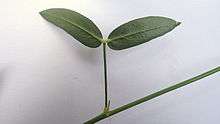Zornia latifolia
| Zornia latifolia | |
|---|---|
 | |
| Scientific classification | |
| Kingdom: | Plantae |
| (unranked): | Angiosperms |
| (unranked): | Eudicots |
| (unranked): | Rosids |
| Order: | Fabales |
| Family: | Fabaceae |
| Subfamily: | Faboideae |
| Genus: | Zornia |
| Species: | Z. latifolia |
| Binomial name | |
| Zornia latifolia Sm.[1] | |
| Synonyms | |
|
Zornia gracilis | |
Zornia latifolia is a species of flowering plant in the legume family, Fabaceae. It is native to South America.[1] Its distribution may extend into Central and North America.[3] It is also known as a naturalized species in tropical western Africa.[1] The plant is known commonly as maconha brava.[4]
Description
This plant is a perennial herb with a branching stem taking a prostrate form on the ground and growing up to about 50 centimeters long. The leaves are bifoliolate, each made up of two leaflets, which are widely lance-shaped and up to 4 centimeters long. At the base is a stipule up to a centimeter in length. The herbage is hairless to lightly hairy. The inflorescence is a spike of up to 35 yellow flowers each about a centimeter long. The flowers open for only 5 to 10 hours. The bractlets are longer than the flowers and may cover them. The fruit is a spiny, hairy legume pod.[5]
Ecology
In its native range it grows in savanna habitat with acidic and low-fertility soils. It tolerates drought, but does not tolerate cold or shade.[5] In Africa it grows as a weed in lawns and on roadsides.[3]
The plant is susceptible to plant pathogens such as the fungi Sphaceloma zorniae, which causes scab disease, and Meliola species, which cause stunting and distortion of the leaves. Insect pests include the red-necked peanutworm moth (Stegasta bosqueella).[5]
Uses
Forage
This legume is a nutritious and palatable forage for livestock. It can be grown as a companion plant to grasses such as Andropogon gayanus and Brachiaria decumbens.[5]
Drugs
This plant is part of many synthetic cannabis mixtures, such as 'Spice'.[4][6]
References
| Wikimedia Commons has media related to Zornia latifolia. |
- 1 2 3 Zornia latifolia. Germplasm Resources Information Network (GRIN).
- ↑ Zornia latifolia. The Plant List.
- 1 2 Zornia latifolia. FAO.
- 1 2 Fattore, L. and W. Fratta. (2011). Beyond THC: the new generation of cannabinoid designer drugs. Frontiers in Behavioral Neuroscience 5, 60.
- 1 2 3 4 Zornia latifolia. TropicalForages.
- ↑ Hruba, L., et al. (2012). Apparent inverse relationship between cannabinoid agonist efficacy and tolerance/cross-tolerance produced by Δ9-tetrahydrocannabinol treatment in rhesus monkeys. Journal of Pharmacology and Experimental Therapeutics 342(3), 843-49.